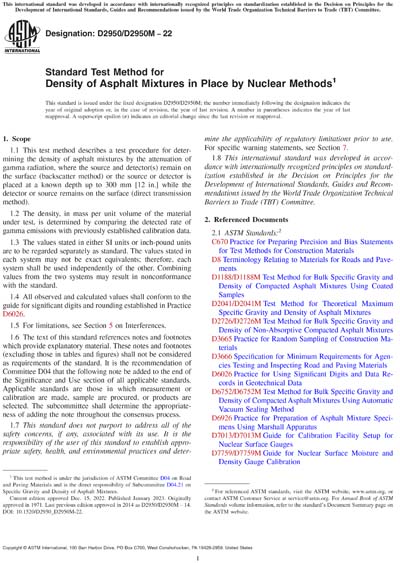Most recent
ASTM D2950/D2950M-22
Standard Test Method for Density of Asphalt Mixtures in Place by Nuclear Methods
1.1This test method describes a test procedure for determining the density of asphalt mixtures by the attenuation of gamma radiation, where the source and detector(s) remain on the surface (backscatter method) or the source or detector is placed at a known depth up to 300 mm [12 in.] while the detector or source remains on the surface (direct transmission method).
1.2The density, in mass per unit volume of the material under test, is determined by comparing the detected rate of gamma emissions with previously established calibration data.
1.3The values stated in either SI units or inch-pound units are to be regarded separately as standard. The values stated in each system may not be exact equivalents; therefore, each system shall be used independently of the other. Combining values from the two systems may result in nonconformance with the standard.
1.4All observed and calculated values shall conform to the guide for significant digits and rounding established in Practice D6026.
1.5For limitations, see Section 5 on Interferences.
1.6The text of this standard references notes and footnotes which provide explanatory material. These notes and footnotes (excluding those in tables and figures) shall not be considered as requirements of the standard. It is the recommendation of Committee D04 that the following note be added to the end of the Significance and Use section of all applicable standards. Applicable standards are those in which measurement or calibration are made, sample are procured, or products are selected. The subcommittee shall determine the appropriateness of adding the note throughout the consensus process.
1.7This standard does not purport to address all of the safety concerns, if any, associated with its use. It is the responsibility of the user of this standard to establish appropriate safety, health, and environmental practices and determine the applicability of regulatory limitations prior to use. For specific warning statements, see Section 7.
1.8This international standard was developed in accordance with internationally recognized principles on standardization established in the Decision on Principles for the Development of International Standards, Guides and Recommendations issued by the World Trade Organization Technical Barriers to Trade (TBT) Committee.
ASTM International [astm]

